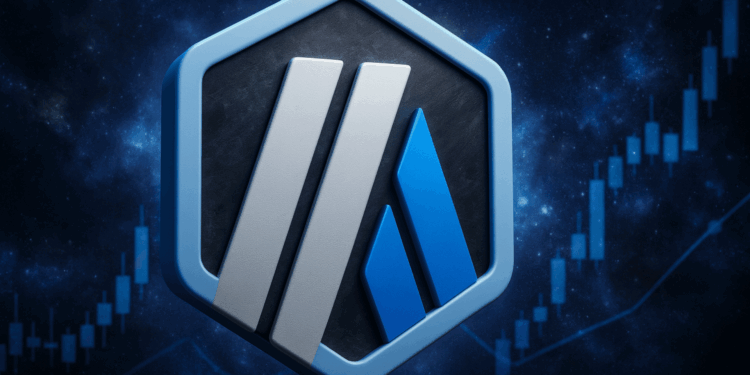- Arbitrum is a Layer 2 scaling solution using Optimistic Rollups to make Ethereum faster, cheaper, and more scalable.
- It offers EVM compatibility, low fees, instant confirmations, and developer-friendly tools like Stylus.
- The 2025 roadmap includes hybrid rollups, cross-chain interoperability, and expanded governance—making ARB a strong long-term play.
Ethereum’s rise to dominance in the decentralized world has been nothing short of revolutionary. But with its success came a bottleneck—crippling gas fees, sluggish transaction speeds, and a scalability ceiling that threatened to stall innovation. Enter Arbitrum, the Layer 2 solution developed by Offchain Labs, which has rapidly evolved from a promising rollup experiment into a full-blown ecosystem powerhouse.
With billions in total value locked, a thriving developer community, and a roadmap that reads like a manifesto for Ethereum’s future, Arbitrum is a scaling solution that is rewriting the rules. So, let us take a closer look at the architecture, mechanics, and momentum behind this next-generation Layer 2.
What Is Arbitrum?
At its core, Arbitrum is a L2 protocol designed to improve Ethereum’s performance without compromising security or decentralization. Unlike solutions that attempt to alter the Ethereum base layer, Arbitrum operates alongside Ethereum, creating a parallel chain that executes smart contracts off-chain and posts only summary results to Ethereum’s mainnet. This reduces the load on Ethereum while maintaining compatibility with existing infrastructure.
The platform was co-founded by Ed Felten, a computer science professor at Princeton, and launched by Offchain Labs in 2018. Its primary objective is to address the blockchain trilemma: scalability, security, and decentralization. By leveraging Optimistic Rollups, Arbitrum can process transactions faster and cheaper while retaining Ethereum’s trust model. This makes it a preferred choice for developers, projects, and users seeking high-performance solutions without compromising the decentralized ethos of the Ethereum ecosystem.
Core Components
Arbitrum’s architecture is built around several interconnected components that together enable faster, cheaper, and more efficient blockchain operations. Each component plays a unique role in delivering a robust L2 solution. This includes:
Arbitrum Rollup
The Arbitrum Rollup is the backbone of the ecosystem. It aggregates multiple off-chain transactions into a single batch that is then posted to Ethereum. By doing so, it minimizes the number of transactions recorded directly on Ethereum, which in turn drastically reduces gas fees and network congestion.
This component is critical because it allows developers to deploy complex smart contracts and dApps without being limited by Ethereum’s high transaction costs or throughput constraints. With Arbitrum Rollup, users experience faster transaction confirmations, and developers can focus on building innovative applications without worrying about scalability bottlenecks.
Arbitrum Chain
The Arbitrum Chain operates in parallel with Ethereum, acting as the execution environment for smart contracts and dApps. It supports the full Ethereum Virtual Machine (EVM), ensuring that contracts written for Ethereum can run seamlessly on Arbitrum without modification.
The chain employs a system of validators and managers, which oversee contract execution and verify outcomes. This localized verification approach reduces the computational burden on each participant, allowing the network to scale more efficiently. By creating a dedicated space for contract execution, the Arbitrum Chain ensures faster processing while maintaining Ethereum-level security through its rollup design.
Arbitrum Bridge
The Arbitrum Bridge is the secure conduit between Ethereum and the Arbitrum Chain. It allows users to transfer Ether (ETH) and ERC-20 tokens to and from the L2 network. By using EthBridge contracts, users can deposit assets into Arbitrum, transact off-chain, and later withdraw them back to Ethereum.
The bridge is essential because it maintains interoperability between Ethereum and Arbitrum. Users retain full control over their funds, while projects benefit from seamless integration across layers. Additionally, the transparency of bridge transactions ensures that all off-chain operations are verifiable on Ethereum, preserving trust in the system.
ARB Token
The native token of the Arbitrum ecosystem, ARB, serves multiple purposes. It secures the network, incentivizes validators and participants, and enables decentralized governance. ARB holders can vote on protocol upgrades, governance proposals, and other ecosystem decisions, ensuring that the platform evolves in alignment with community interests.
Its significance extends beyond governance. By rewarding participants who validate transactions and maintain network integrity, ARB encourages active engagement and strengthens the overall reliability of the Arbitrum network.
How Does It Work?
Arbitrum leverages Optimistic Rollup technology to deliver scalability without compromising security. In this model, transactions are assumed valid unless challenged within a predefined window. If a dispute arises, a bisection protocol resolves the disagreement, breaking it down to a single instruction and requiring minimal computation to validate. This reduces the need for every validator to execute every transaction in full, saving time and resources.
At the heart of Arbitrum is the Arbitrum Virtual Machine (AVM). Contracts run as virtual machines with designated managers and verifiers. Managers execute and validate contract logic, while verifiers track only the hash of the VM state rather than the full data. This design allows rapid consensus while keeping the network secure.
Arbitrum also uses ArbGas to measure execution costs on its chain. ArbGas fees are significantly lower than Ethereum gas, reflecting the reduced resource demand of off-chain execution. Together, these mechanisms enable faster processing, lower fees, and secure transaction finality, providing a superior user experience compared to direct Ethereum transactions.
What Problems Does It Solve?
Arbitrum addresses several critical issues that have long plagued the Ethereum network. This includes:
- Scalability – Ethereum’s limited transaction capacity has long been a bottleneck. Arbitrum offloads execution to Layer 2, enabling thousands of transactions per second and reducing congestion on the mainnet.
- High Fees – By compressing transaction data and executing off-chain, Arbitrum slashes gas fees to a fraction of Ethereum’s. This makes DeFi, gaming, and NFT platforms more accessible to everyday users.
- Latency – Transactions on Arbitrum are confirmed instantly by the sequencer, providing a smoother user experience. While withdrawals to Ethereum take longer, fast-bridge services mitigate the delay.
- Developer Friction – Arbitrum’s full EVM compatibility and support for WASM-based languages via Stylus make it a developer-friendly environment. Builders can deploy dApps with minimal changes and optimize performance where needed.
- Security Trade-offs – Unlike some Layer 2s that sacrifice decentralization for speed, Arbitrum maintains Ethereum-grade security through fraud proofs and validator incentives.
Utility and Offerings
The Arbitrum ecosystem offers a range of functionalities designed to benefit developers, users, and the broader crypto community. Some key utilities and offerings include:
Token Swaps and DApps
Arbitrum supports decentralized exchanges, enabling users to swap tokens at lower fees than Ethereum. These swaps utilize only layer 2 liquidity, ensuring fast execution and reduced costs. Users benefit from seamless interaction with dApps while enjoying an enhanced trading experience.
Running dApps
Developers can deploy dApps on Arbitrum using the AVM, selecting validators and observers to monitor execution. The AnyTrust Guarantee ensures correct execution even if only one validator behaves honestly. This structure encourages community participation while maintaining trust in application logic.
Developer Incentives
Arbitrum DAO funds grants for dApp developers, infrastructure projects, and research teams. This fosters innovation and ensures the ecosystem continues to evolve.
Governance
ARB token holders can vote on protocol upgrades and governance decisions. This decentralized model ensures that the ecosystem evolves based on community priorities and incentives. Governance participation aligns user interests with network development, fostering a collaborative ecosystem.
Interoperability
The Arbitrum Bridge allows seamless movement of assets between Ethereum and Arbitrum. This feature ensures that users and projects can interact with multiple networks while retaining full control of funds, promoting ecosystem fluidity and cross-chain integration.
Stylus Contracts
Stylus is an upgrade that brings WebAssembly (WASM) into the Arbitrum ecosystem. The upgrade has unlocked high-performance smart contracts in Rust, C, and C++. Developers can build faster, more efficient applications without abandoning Ethereum compatibility.
Key Milestones and Highlights
Arbitrum’s ecosystem has seen rapid adoption and growth, attracting developers, projects, and institutional interest. Some key highlights include:
- DeFi Expansion – Platforms like SushiSwap, and Curve have integrated Arbitrum to leverage lower fees and faster transactions. Uniswap has also explored migration, reflecting growing confidence in L2 solutions.
- Developer Engagement – Arbitrum actively fosters its developer community by providing open-source tools, libraries, and resources. Incentive programs encourage innovation and support the deployment of new dApps.
- Institutional Interest – Investors and crypto funds recognize Arbitrum’s potential as a high-performance layer 2 solution, leading to collaborations, partnerships, and funding opportunities.
- Network Growth – Continuous onboarding of projects and users has expanded Arbitrum’s footprint, making it one of the leading layer 2 solutions in the Ethereum ecosystem.
Roadmap and Plans Ahead
Looking forward, Arbitrum is poised to maintain its leadership in layer 2 scaling while exploring future innovations. Key initiatives include:
- ZK Proof Integration – Exploring hybrid models that combine Optimistic and ZK rollups for enhanced security and privacy.
- Expanded Ecosystem – The team aims to onboard more DeFi, NFT, and gaming projects, broadening the network’s utility and adoption.
- Cross-Chain Bridges – Improved interoperability with other blockchains and L2 networks will allow seamless asset transfers and cross-chain dApp functionality.
- Stylus Optimization – Enhancing performance and expanding language support for smart contracts.
- Enhanced Governance – ARB token governance will evolve with new voting mechanisms and community proposals to further decentralize decision-making.
Final Thoughts
In conclusion, Arbitrum stands as a bold reimagining of Ethereum scalability, transforming how transactions and smart contracts interact with the blockchain. Its Optimistic Rollup framework, combined with the Arbitrum Chain and Bridge, delivers near-instant execution, drastically reduced fees, and developer-friendly compatibility, creating a fertile ground for innovative dApps. So, as the ecosystem continues to expand, it will be interesting to see how Arbitrum reshapes decentralized finance, gaming, and Web3 innovation while challenging conventional limits of blockchain performance.














